Last month, January 2025, emerged as the warmest January on record globally, intensifying concerns among climate scientists about the accelerating pace of climate change. The European Copernicus Climate Service revealed that temperatures surpassed the previous January record by nearly 0.1°C, despite predictions of a cooler month due to a shift away from the natural weather pattern known as El Niño.
Gavin Schmidt, director of NASA's Goddard Institute for Space Studies, pointed out that the fundamental driver behind rising temperatures remains the increase in greenhouse gas emissions, primarily from human activities such as fossil fuel combustion. However, the specific reasons behind January's substantial warmth remain unclear. This recent record contributes to an ongoing trend of significantly high temperatures observed since mid-2023, with readings approximately 0.2°C above expectations.
In contrast to the previous year, when global temperatures were pushed higher by the El Niño weather phenomenon, January 2025 experienced developing La Niña conditions, which typically are associated with cooler temperatures. Adam Scaife, head of monthly to decadal predictions at the UK Met Office, expressed surprise at the unexpected warmth, highlighting the unknown factors that could have contributed.
Some theorize that the mild La Niña conditions, which may take time to fully influence temperatures, could explain the anomaly. Others suggest that recent warmer sea temperatures globally indicate a shift in ocean behavior. Samantha Burgess, deputy director of Copernicus, emphasized the importance of monitoring ocean temperatures, as they have a direct correlation to air temperatures.
Another possible explanation for rising temperatures could be the declining levels of atmospheric aerosols, tiny particles that have historically mitigated the effects of greenhouse gases by reflecting sunlight. James Hansen, a noted climate scientist, warned that less aerosol presence due to efforts to clean the air in regions like China could lead to underestimated climate risks.
While there remains skepticism regarding the role of aerosols, some researchers warn of a potential "nightmare scenario" in which diminishing reflective clouds could exacerbate warming. As scientists continue their investigations, the future remains uncertain. Although many anticipate a slight dip in temperatures for 2025 compared to previous years, the recent warmth signals that new records could emerge as long as greenhouse gas emissions persist.
Dr. Burgess noted that if the current trajectory continues, 2025 could eventually be considered one of the cooler years in a rapidly warming climate.





















